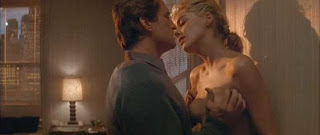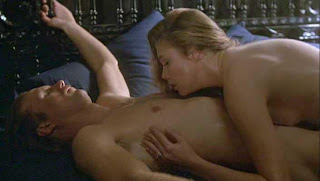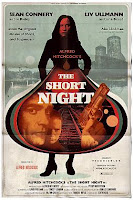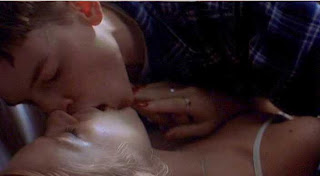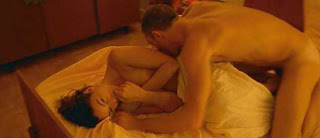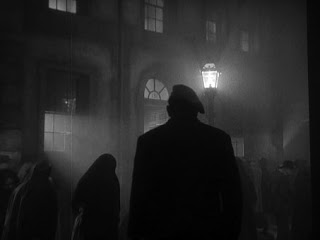A Long Time Ago..
Hey guys,
32 years ago today a little film called Star Wars was released in only 32 theaters. To celebrate, I thought I’d repost a favorite article from a couple of years ago for Ed Copeland’s Star Wars Blog-A-Thon.
Two great lessons about SW that I hold dear to this day:
* The early drafts were so stunningly awful and so unlike the finished film, it’s such a great reminder that any bad script has the potential to reach great heights like Star Wars.
* Lucas had the amazing ability to scrap a script he just wrote and approach the story again from a completely different perspective, which he did repeatedly before settling on Luke and the hero’s arc. We all need this quality. Too many of us get too stuck on what we write and we lack the discipline to start from scratch or even approach our stories from a different perspective just to see how it plays.
Hope you enjoy it.
-MM
--------------------------
And subsequently changed the world.
 In celebration of not only the 30th anniversary of Star Wars but also the Star Wars Blog-A-Thon, which is being hosted by our very good friend Edward Copeland, I thought I’d have a little fun and talk about the early drafts of Star Wars.
In celebration of not only the 30th anniversary of Star Wars but also the Star Wars Blog-A-Thon, which is being hosted by our very good friend Edward Copeland, I thought I’d have a little fun and talk about the early drafts of Star Wars.Thus, I tried my very best to read all six drafts - May 1974, July 1974, January 1975, August 1975, January 1976, and February 1977. Yeah, that was a bit much. Each one of those suckers is filled with about 30,000 words.
So I’d like to concentrate on the very first draft, which was titled simply The Star Wars. (Lucas would go on to title later drafts Star Wars: Adventures of the Starkiller, God help us all, but thankfully, he came to his senses and in the end stuck with Star Wars: A New Hope.)
Let it be said, my friends, that the early drafts of Star Wars should be a rich source of encouragement to every aspiring screenwriter the world over - because they royally sucked. They are of the same low, amateurish quality that may be found in many first screenplays written by newbies on TriggerStreet. (Thus, many scripts and new writers have the potential to reach Star Wars heights.) Had Star Wars never happened, had Lucas uploaded his first draft onto TriggerStreet, and had he theoretically asked me to review his script for him, I’m not sure I could’ve even finished reading the darn thing.

Let’s compare the opening scenes of the 1974 draft vs. the 1977 draft.
The 1974 draft opens with a shot of space and “the vast blue surface of the planet, Utapau. Five small moons slowly drift into view from the far side of the planet.”
The main titles roll-up:
“Until the recent Great Rebellion, the Jedi Bendu were the most feared warriors in the universe. For one hundred thousand years, generations of Jedi perfected their art as the personal bodyguards of the emperor. They were the chief architects of the invincible Imperial Space Force which expanded the Empire across the galaxy, from the celestial equator to the farthest reaches of the Great Rift.
Now these legendary warriors are all but extinct. One by one they have been hunted down and destroyed as enemies of the New Empire by a ferocious and sinister rival warrior sect, the Knights of Sith.”
And then:
A small silver spacecraft emerges from behind one of the Utapau moons. The deadly little fightercraft speeds past several of the moons, until it finally goes into orbit around the fourth moon.
Now consider the 1977 version:
First, the roll-up:
“It is a period of civil war. Rebel spaceships, striking from a hidden base, have won their first victory against the evil Galactic Empire.
During the battle, Rebel spies managed to steal secret plans to the Empire's ultimate weapon, the Death Star, an armored space station with enough power to destroy an entire planet.
Pursued by the Empire's sinister agents, Princess Leia races home aboard her starship, custodian of the stolen plans that can save her people and restore freedom to the galaxy...”
And then the action:
The awesome yellow planet of Tatooine emerges from a total eclipse, her two moons glowing against the darkness. A tiny silver spacecraft, a Rebel Blockade Runner firing lasers from the back of the ship, races through space. It is pursed by a giant Imperial Stardestroyer. Hundreds of deadly laserbolts streak from the Imperial Stardestroyer, causing the main solar fin of the Rebel craft to disintegrate.
The first is just setting and backstory. And it’s boring. The second is setting, backstory, establishes the conflict, and then we’re thrown right into action with this little spacecraft being chased down by a giant Imperial Stardestroyer. It also sets up better the expectation of the thrills to come and makes a very clear visual statement.
Of this statement, I loved what Barry Toffoli said at Scanners:
“Star Wars" opens with a shot of space and the soft sound of John Williams score, then the shot shifts to a planet. So right away we know we’re in for adventure on foreign soil, in outer space no less. Then a small vessel comes from the top of the screen. This is quickly followed by a series of blasts as the score turns into that famous booming on sound, akin to Gustav Holst’s ‘Mars’ [from "The Planets"]. This is all quickly followed by the enormously famous and copied shot of a behemoth star cruiser coming in from the top of the screen and going on forever. It doesn’t take long to figure out that this story is a tale of good versus evil, the little guy getting bullied by the big guy. Even the planet in the shot plays into the theme, representing a new undiscovered world a new hope for freedom and life. But we know the journey will be hard as the star cruiser looms over everything from the rebel ship to the planet below to the audience watching it in the theatre.

Following the opening sequence (in the first draft), we find ourselves on the wastelands of the fourth moon called Utapau with an 18-year-old Annikin Starkiller (who would eventually become Luke Skywalker). He’s wearing a “breath mask” and “goggles.” He’s surveying something with his “electrobinoculars.” He runs home. We’re introduced to his younger brother, Deak, and his father, Kane Starkiller, who is a master Jedi. The three go out into the wasteland together to investigate a Sith spacecraft that had landed nearby. His father leaves the boys to get a closer look. While he’s gone a “sinister Sith warrior” attacks Annikin and Deak. “Laserswords” are drawn. The Sith kills Deak. And just when Annikin is about to die, he is saved by his father. (All of this business about Jedis and Siths and laserswords was just too much too soon.)
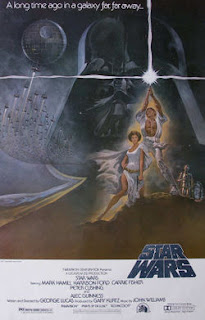 Darth Vader is just a “tall, grim-looking general.” We see the Emperor tell his troops about a forthcoming battle and the Empire’s intent to conquer the Aquilaean System, “the last of the independent systems, and the last refuge of the outlawed, vile sect of the Jedi.” It is a system that will bring them “more scientific wealth than that of any other House in the Tribunal.” They will easily “gain control of the directorship.” Oh. Nice.
Darth Vader is just a “tall, grim-looking general.” We see the Emperor tell his troops about a forthcoming battle and the Empire’s intent to conquer the Aquilaean System, “the last of the independent systems, and the last refuge of the outlawed, vile sect of the Jedi.” It is a system that will bring them “more scientific wealth than that of any other House in the Tribunal.” They will easily “gain control of the directorship.” Oh. Nice.The armies of Aquilae are led by an old Jedi – General Luke Skywalker. “He is a large man, apparently in his early sixties, but actually much older. Everyone senses the aura of power that radiates from this great warrior. Here is a leader: a Jedi general. He looks weary, but is still a magnificent-looking warrior. His face, cracked and weathered by exotic climates, is set off by a close silver beard, and dark, penetrating eyes.”
Kane and his son just sort of... show up. Kane’s old friends with Skywalker. He begs Skywalker to take Annikin as his Padawan Learner in order to be a complete Jedi, because he is too old to complete his training. Annikin’s already reached “the fifth stage.” Skywalker reluctantly accepts him. And then Kane takes off for “the spaceport at Gordon to visit an old friend, Han Solo, the Ureallian.”
And from here, the story descends into the seventh circle of screenwriting hell.
There’s this business about Skywalker desperately trying to get a “war code” in order to “start the war computers” and send his troops into space to be ready for an imminent attack by the Empire, but he can’t get it until there’s a vote about an alliance treaty. And then they say, “May the force of others be with you all.”
Skywalker learns about a death star, which we never see, but we see “a space fortress.” Maybe they were the same thing. I'm not sure. In any case, they’ll be attacking at sunrise. He sends Starkiller to get Princess Leia to bring her to safety.
And here’s the basic arc of their sordid relationship.

First encounter:
STARKILLER
Forget the cases - we've no time.
LEIA
These are my things. They must...
STARKILLER
I said forget them, and hurry...
LEIA
Just who do you think you are?
Starkiller grabs the princess by the arm, and hauls her to the speeder. Mina and the old women run after them.
LEIA
I will not be treated like this! You bring my things.... My father will have your head... (etc.)
Leia struggles to break away from the young warrior's grasp as he opens the door of the speeder.
STARKILLER
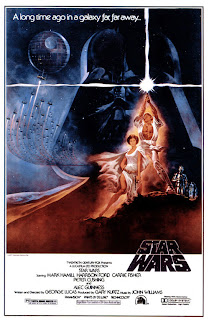
Settle down!
When the door to the speeder is opened, Mina starts in, and Starkiller stops her.
STARKILLER
You must stay. Here, take the Crest.
Starkiller rips the royal crest from the princess' neck, and hands it to the startled handmaiden. The old women gasp in horror. The princess starts hitting Starkiller with little result.
PRINCESS
Mina's not staying...I'm not leaving her. You can't....
Starkiller punches her square on the jaw and knocks her cold. Mina is panic stricken, one of the old women faints, and another starts for Starkiller with a large staff.
STARKILLER
She'll be all right. I'm taking her to safety...as ordered. You will wear the crest and continue as before.
Later as they are flying along in a landspeeder:
PRINCESS
You are such a barbarian. I'll have my father cut you into little pieces when we get back...and I'll take pleasure in feeding you to the Gonthas....a little bit each day. I may save your eyes though. I'll have them petrified and made into a necklace.
STARKILLER
Your sweetness is only surpassed by your beauty. Just try to remember, I'm only following orders.
PRINCESS
... to beat me and abuse me?
STARKILLER
I'm afraid I've only learned one way to treat wild animals.
And then, somehow, they fall in love:
LEIA
Will we make it? Is there any hope? Stay with me... I love you.
Starkiller is slightly shocked at this outburst. The princess starts to cry and clings to him for support.
STARKILLER
No-one is going to die...so stop acting like a child, and start behaving like a queen. What is this silly talk of love? You belong to the people of Aquilae, and my job is to return you to them, nothing more. Now straighten up and get into a lifepod.
She's deeply hurt by his callousness. She breaks away from him and runs down a hallway into a lifepod. He is tired, and angry at the whole incident.
And in the very next scene:
WHITSUN
What's going on with you two?
STARKILLER
We're in love. She loves me, and I just realized... I love her.
Pardon me while I heave.

There were two androids. They were annoying. "Artwo" could speak.
THREEPIO
This is madness; we're going to be destroyed. I'm still not accustomed to space travel.
ARTWO
The external bombardment does appear to be concentrated in this area. The structure has exceeded the normal stress quotient by point four, although there appears to be no immediate danger.
THREEPIO
No immediate danger! You're faulty. This is madness!
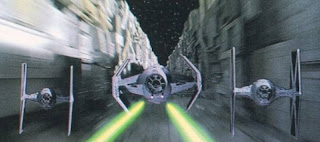
Because they’re losing the battle to the Empire, they decide to take the Princess and 33 of the greatest scientific minds to the Ophuchi system to be safe. But they don’t actually take the scientists.
The doctor moves over to a safe-like cabinet guarded by two attendants. The doctor gingerly picks up a small clear vial filled with grey fluid. It has a label which reads: Faubun, Astro-dynamics...In the background the scholar on the operating table is undergoing a form of mechanized brain surgery.
GENERAL
"Bloodory's distillation?"
DOCTOR
Yes. It has been greatly perfected. The brain is condensed into five ounces of fluid. Cloning cell samples are included so that a structural duplicate of the scientist can be reproduced. When the duplicate child reaches the age of six, he or she begins a series of injections of the brain fluid. By the age of ten years, they have received all the knowledge and memory of an experienced scientist: an old mind in a young body. We have prepared a special shock-belt to carry the vials.
I’ll bet that was fashionable.

Here’s the rest of the story, which was woefully inadequate:
- Skywalker, Starkiller and company try to flee with the princess (and scientists floating inside their special shock-belts).
- The escape attempt fails and they crash land on the planet Yavin.
- They lose the princess.
- They’re taken in by “Wookees,” whose colony is run by Chewbacca.
- The Empire captures the princess and takes her to the “space fortress.”
- Skywalker and company teach the “Wookees” how to fly a spacecraft.
- And then the “Wookees” fly the spacecrafts into outer space and attack the “space fortress.” Vader tells Leia, “I'm afraid I have no more time to deal with you. A senseless and futile attack by your friends has forced me to take a rather unpleasant course of action. Your execution will have to be expedited.”
- Skywalker and Starkiller board the “space fortress,” rescue the princess, take her to a spacecraft, and float away with the garbage, while the “Wookees” continue the attack and eventually blow up the “space fortress.”
- There is much celebrating in the end.
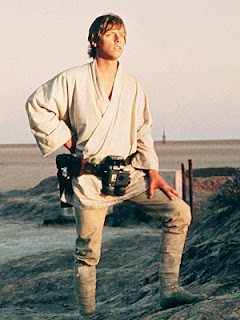 Okay, I should make at least one serious point here. Let me ask a question: why should we care about this kid, Annikin Starkiller, who gets pushed off onto General Skywalker? Here, I think we find some of the great lessons in the transformation of Star Wars as a story. It’s not just about special effects and being entertaining and being halfway intelligent (please!) about the relationships between these characters. This is about having a protagonist who has a goal. In this first draft (and second), Annikin is just a young adult who has almost completed his training and seems likely to do so. And then we just watch him in action. Yawn. So what? He’s all set!
Okay, I should make at least one serious point here. Let me ask a question: why should we care about this kid, Annikin Starkiller, who gets pushed off onto General Skywalker? Here, I think we find some of the great lessons in the transformation of Star Wars as a story. It’s not just about special effects and being entertaining and being halfway intelligent (please!) about the relationships between these characters. This is about having a protagonist who has a goal. In this first draft (and second), Annikin is just a young adult who has almost completed his training and seems likely to do so. And then we just watch him in action. Yawn. So what? He’s all set!But consider the final version in which we’re given a young Luke Skywalker who not only has an inner goal to be a hero Joseph Campbell style, but he’s also disadvantaged because of his circumstances, and they're holding him back from being what he really wants to be. Who couldn’t sympathize with that? When Luke stared at that horizon on Tatooine and those two setting suns and longed for something better, we longed with him and rooted for him to get it. When his parents were murdered we knew he was on a trajectory for a great adventure that we were very ready to go on with him. And so we were introduced to this great universe through Luke and his inner needs, which made all the difference in the world.
By the way, George, I am interested to know what the hell happened to those scientists floating around in those little bottles on Skywalker's shock-belt. I guess they're okay now.
May the force of others be with you all.
